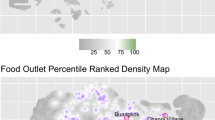Abstract
Objectives
This aim of this study was to describe the association between shopping difficulty and food accessibility for elderly people living alone in Japan.
Design
A cross-sectoral, multilevel survey was designed to measure shopping difficulty from a food accessibility perspective. The questionnaire was distributed by mail.
Setting
The sample was drawn from seven towns and cities across Japan.
Participants
A geographic information system was used to select the sample: it identified the proximity of elderly people living alone to a supermarket. In total, 2,028 elderly people (725 men and 1,303 women) responded to the questionnaire.
Measurements
The binary dependent variables were shopping is easy/shopping is difficult. A logistic regression analysis adjusting for age and area of residence and using stepwise variable analyses was performed.
Results
The response rate was 58.6%. Overall, 14.6% of elderly men and 21.7% of elderly women consider shopping difficult. The stepwise logistic analysis showed that the food accessibility factors strongly related to shopping difficulty are infrequent car use (women: OR = 6.97), walking difficulties (men: OR = 2.81, women: OR = 3.48), poor eyesight (men: OR = 2.26, women: OR = 1.75), not cooking lunch by oneself (men: OR = 1.63, women: OR = 1.72), not having anyone to help with food shopping (women: OR = 1.45) and living over 1 km away from a supermarket (men: OR = 2.30, women: OR = 2.97).
Conclusion
The study concludes that elderly people’s assessment of shopping difficulty is related to their food accessibility. Important food accessibility aspects include car or motorbike ownership, walking continuously for 1 km, poor eyesight, and having cooking skills and having someone to help with shopping. These physical activity restrictions have a greater influence on shopping difficulty than do either income or proximity to a supermarket.
Similar content being viewed by others
References
Cabinet office (2014) Current status and future outlook on aging. Annual report on the aging society. 2-3,14 [serial on the Internet]. [cited 2015 September 27]: Available from http://www8.cao.go.jp/kourei/english/annualreport/2014/pdf/c1-1.pdf
WHO (2015) Food security [serial on the Internet]. [cited 2015 September 27]:Available from http://www.who.int/trade/glossary/story028/en/.
Ministry of Economy, Trade and Industry (2015) Report on the current situation of shopping difficulty, food desert issue and future measures (in Japanese) [serial on the Internet]. [cited 2015 September 27]: Available from http://www.meti.go.jp/policy/economy/distribution/kaimonoshien2010.html.
Ministry of Agriculture, Forestry and Fisheries, Policy research institute (2014) The situation of food access and the directionality of measures 2014. [in Japanese] [serial on the Internet]. [cited 2014 March 16]: Available from http://cse.primaff.affrc.go.jp/katsuyat/.
Ishikawa M, Yokoyama T, Murayama N. Relationship between geographical factorinduced food availability and food intake status; A systematic review. Jpn J Nutr Diet. 2013;71: 290–297
Thompson JL, Bentley G, Davis M, Couson J, Stathi A, Fox KR. Food shopping habit, physical activity and health-related indicators among adults aged =70 years. Public Health Nutrition 2011;14: 1640–1649
Lang M, Neal H. An empirical test of experiential shopping in food retailing. British Food Journal 2013;115: 639–652
Takahashi K, Yakushiji T. Difficulties in accessing food and their countermeasures on local governments: using GIS of Grid-Square statistics and analysis of all municipality consciousness. Journal of Food System Research 2013;20: 26–39
Yakushiji T, Takahashi K. Accessibility to grocery stores in Japan, A comparison between urban and rural areas by measuring the distance to stores. Journal of Food System Research 2014;20: 14–25
Aggarwai A, Cook AJ, Jiao J, Seguin RA, Vemez Moudon A, Hurvitz PM, Drewnowski A. Access to supermarkets and fruit and vegetable consumption. Am J Pubic Health 2014;104: 917–923
Rose D, Richards R. Food store access and household fruit and vegetable use among participants in the US Food Stamp Program. Pub Health Nutr 2004;7: 1081–1088
Chow H, Chen HC, Lin LL. Association between out-of-home trips and older adults’ functional fitness. Geriatr Gerontol Int 2014;14: 596–604
Hanabuchi T, Kondo K, Nakaya T, Nakade M, Ojima T, Hirai H, Kawachi I. Neighborhood food environment and body mass index among Japanese older adults: results from the Aichi Gerontological Evaluation Study (AGES). Int J Health Geogr 2011;doi: 10.1186/1476-072X-10-43.
Ministry of Health, Labour and Welfare (2012). Report of National Health and Nutrition Survey, Japan 2010. Publishing: Ministry of Health, Labour and Welfare. (in Japanese) [serial on the Internet]. [cited 2015 September 27]: Available from http://www.mhlw.go.jp/bunya/kenkou/eiyou/h22-houkoku.html
Tarasuk VS. Household food insecurity with hunger is associated with women’s food intakes, health and household circumstances. J Nutr 2001;131: 2670–2676
Burns C, Bentley R, Thornton L, Kavanagh L. Reduced food access due to a lack of money, inability to lift and lack of access to a car for food shopping: a multilevel study in Melbourne, Victoria, Public Health Nutrition 2011;14: 1017–1023
Chia-Yu Chen R, Lee MS, Chang YH, Wahqvist ML. Cooking frequency may enhance survival in Taiwanese elderly. Public Health Nutrition 2011;15: 1142–1149
Kim K, Kim MK, Shin YJ, Lee SS. Factors related to household food insecurity in the republic of Korea. Public Health Nutrition 2011;14: 1080–1087
Galves M, Morland K, Raines C, Kobil J, Siskind J, Godbold J, Brenner B. Race and food store availability in an inner-city neighbourhood. Public Health Nutrition 2008;11: 624–631
Budzynska K, West P, Savoy-Moore RT, Lindsey D, Winter M, Newby PK. A food desert in Detroit; Associations with food shopping and eating behaviors, dietary intake and obesity. Public Health Nutrition 2013;16: 2114–2123
Winder MJ, Metcalf SS, Bar-Yam Y. Developing a Mobile produce distribution system for low-income urban residents in food deserts. J Urban health 2012;89: 713–745
McEntee J. Highlighting food inadequacies: does the food desert metaphor help this cause? British Food Journal 2009;111: 349–363
Vahabi M, Schindel Martin L. Food security: who is being excluded? A case of older people with dementia in long term care homes. J Nutr Health Aging 2014;18: 685–691
Author information
Authors and Affiliations
Corresponding author
Rights and permissions
About this article
Cite this article
Ishikawa, M., Yokoyama, T., Nakaya, T. et al. Food accessibility and perceptions of shopping difficulty among elderly people living alone in Japan. J Nutr Health Aging 20, 904–911 (2016). https://doi.org/10.1007/s12603-015-0694-6
Received:
Accepted:
Published:
Issue Date:
DOI: https://doi.org/10.1007/s12603-015-0694-6




